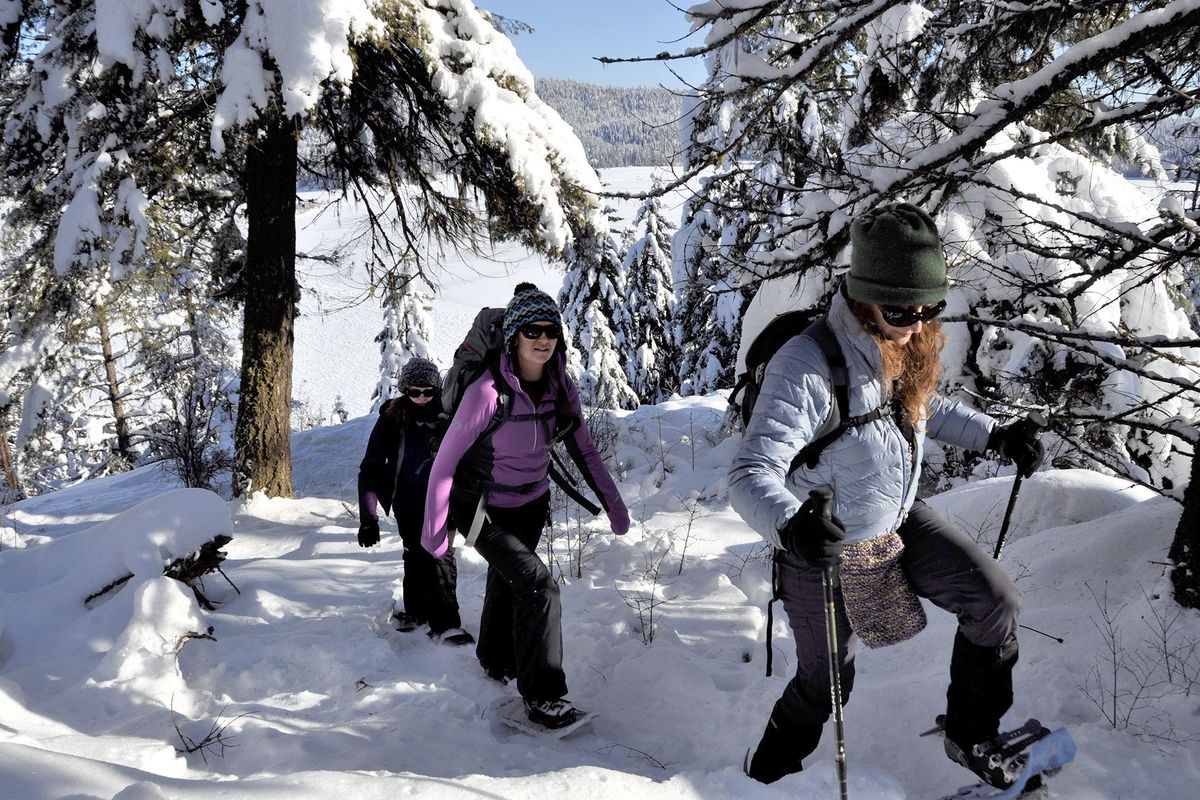Landers: Snowshoeing gains in popularity and access across the region

“All you have to do is strap on modern snowshoes and by the time you walk 10 steps you’re pretty much an expert,” said Beattie, who’s been selling snowshoes for 24 years.
While he still treasures a classic pair of five-foot long cedar-rawhide models, the smaller, ultralight, no-maintenance models being sold today get the credit for the giving the sport its traction for growth.
Perhaps the biggest snowshoeing misconception is that a lot of extra gear is required, he said.
Teamed with gaiters, the waterproof shoes or boots one uses for hiking will work just fine for most snowshoe day hikes. “And newcomers to the sport tend to overdress and get too hot,” he said.
Snowshoes range from simple small flotation platforms ideal for traipsing around a snowy city park to larger models with more flotation and crampons for navigating deeper snow and icy conditions one might encounter stamping into Chimney Rock.
“Size typically is based on body weight,” he said. “Bigger people need bigger snowshoes, with some exceptions. At 180 pounds, I technically would go for a 30-inch snowshoe. But I have a short inseam, so I opt for 25-inchers. I sink about an inch more in the snow but I don’t have to alter my stride, which is more important.”
Although many experienced snowshoers will keep their hands free in reasonable terrain, adjustable length poles with snow baskets are highly recommended for balance and to aid in getting up in a fall, he said.
Snowshoe bindings come in several models. MSR, for instance, makes bindings with multiple straps that readily accommodate wider boots. The Atlas Endeavor models have two straps that might not works for such a wide range of boots, but they’re simple.
“In most cases, I think simple is good,” Beattie said.
Once geared up for snowshoeing, the larger question is where to go.
New devotees to snowshoeing – and there are legions of them – have finally been finding plenty of places this winter to use the truck loads of snowshoes purchased in recent years from retailers ranging from outdoor specialty shops to Costco.
In the past four weeks, there’s been enough snow to make tracks from the city lowlands to the top of Mount Spokane and beyond.
Spokane County Conservation Areas, secured through the voter-approved Conservation Futures property tax levy, have been popular winter destinations.
People were quick to be out after the December snow storms and break trail at a half dozen or more of the larger conservation areas, said Paul Knowles, County Parks planner. “They’re still getting a lot of use,” he said last week.
“I think there’s justification to start calling the (Mount Spokane) snowmobile parking lot the snowshoe parking lot,” said Holly Weiler, a Spokane Mountaineer and Washington Trails Association leader who helped lead more than 40 people on the First Day Hike on Jan. 1 at Mount Spokane State Park.
“Two years ago for the first New Years Day hike, we had two leaders but just one snowshoer showed up,” she said.
Plowed roads and parking access is a consideration at many winter destinations.
“We try to get conservation area trailheads plowed out at some point, but it depends on available resources,” Knowles said. “But snow really generates interest. I’ve seen a huge up-tick in snowshoer use this winter.”
The most popular accessible snowshoeing destinations this winter have included the Slavin, Dishman Hills, McKenzie, Antoine Peak, Haynes, Liberty Lake and Mica conservation areas, he said.
As lowland snow thins out in this week’s warmer temperatures, more snowshoers will head to higher ground and deeper snow until new snow freshens the back-40 base.
Washington Sno-Park areas such as Sherman Pass are dependable destinations for finding plowed parking and good snow. Mount Spokane trails are probably the most popular in the region. Vehicles must display state Sno-Park permits at these sites.
Warming huts especially for snowshoers have been installed by state park rangers and volunteers at Mount Spokane. At Fourth of July Pass, two shelters are maintained by the Panhandle Nordic Club.
The Little Pend Oreille Wildlife Refuge southeast of Colville is a peaceful destination for snowshoeing, along with Turnbull Wildlife Refuge south of Cheney.
Changing conditions must be factored into every trip. The route off Mineral Ridge overlooking Lake Coeur d’Alene’s Wolf Lodge Bay was excellent with rewarding views for snowshoers around the New Year, but portions of it have transformed.
When a snowy trail has been tramped and the weather turns it to ice, the best option may be to leave the snowshoes in the car, fit Yaktrax or MICROspikes onto your boots for traction and simply go for a winter hike.